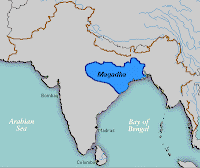
- But of course they are technically different: Satori is an "epiphany" in Zen, whereas kensho is the deeper realization. Buddhist enlightenment means bodhi (fully awakening from the illusion of existence independent of the Five Aggregates of Clinging); this is a permanently liberating insight not the commonly mentioned realization of "oneness" (nonduality).
- No, very different. This may seem like quibbling. This may be quibbling. But it is the central disagreement between the two main Buddhist schools today, the more orthodox Theravada and the more reformed Mahayana. (There are no "Hinayana" schools still in existence, the last one being the ancient Sarvastivada).
 |
| "Just sitting" (zazen) is only one part of Zen training (Elheiji Zen monastery, Japan/Art.com) |
Many Mahayanists today seem to have no idea that this happened, and they sound like Hindus using slightly different terms for the same things. That's beautiful. But that's not Shakaymuni Buddha Gautama's Dharma (teaching, message, dispensation).
 |
| Much meditative bliss may arise, but Four Signs keep one on track: aging, sickness, death... |
The absorptions (jhanas) -- as important as they are to the goal -- do not lead to enlightenment. They lead to rebirth in those exalted states Brahmanism would call "nirvana" or liberation. All rebirths are impermanent; they are not-self; they are unsatisfactory (dukkha, disappointing).
- Stages of Buddhist enlightenment progressively eradicate the ten fetters (samyojana) that bind one to samsara, the otherwise endless round of rebirth and disappointment. Traditionally Buddhism speaks of four stages. Actually the texts divide them in different ways for different reasons. The best explanation is found in the ancient commentarial The Path of Freedom (Vimutti Magga). Abhidharma scholars looked at these stages in different ways.
 The first and most difficult fetter to uproot is at the very heart of the problem -- the one it never seriously occurs to us to actually question: "self view" (sakkaya ditthi), the sense that we are some unchanging self or soul (atta) independently willing, worrying, and having the experience, the homunculus behind the knowing, the "little man" in our head looking out of the eyes and working a control panel.
The first and most difficult fetter to uproot is at the very heart of the problem -- the one it never seriously occurs to us to actually question: "self view" (sakkaya ditthi), the sense that we are some unchanging self or soul (atta) independently willing, worrying, and having the experience, the homunculus behind the knowing, the "little man" in our head looking out of the eyes and working a control panel.He says that some masters hold to one view, and equally reputable masters hold to the other view. Both are correct.
- Yes. It happens one way for some, the other for others. Yet on reflection it is always gradual, that is, based on causes and conditions that were cultivated over time, sometimes many lives. How then is the other true? If efforts in previous lives come to fruition with no effort in this life, enlightenment will seem sudden and unprompted -- "a flash of insight."
Satori
My experience? A person has that one profound mystical experience that hits like a lightning bolt and totally rearranges the psyche [personality, heart, mind, spirit, "soul"].
One experiences a shattering of the individual ego as one realizes a transcendental self existing not only within the personal self but in all beings everywhere.
- This is exactly the popular view Brahminism/Hinduism clings to, which the Buddha rejected as a definition of enlightenment or liberation. Brahmin priests and Jain ascetics (brahmanas and shramanas) -- those temple priests who hold the Vedas as the ultimate authority and those wandering ascetics who, like the Buddha, reject them -- hold the wrong view that consciousness is the soul, the self, the thing to be identified with, the shared essence connecting everyone.
- The Buddha understood that ALL constituents of soul or self (atta) are actually impersonal (an-atta, "not-self").
- Clinging to Brahman (GOD, Godhead, the Universe, the All) or consciousness is not enlightenment, not liberation from rebirth and suffering.
- However sublime the experience or subtle the defilement, it shows that one has NOT broken through to the first and foremost liberating insight taught by the historical Buddha.
- This is probably why Mahayana Buddhism sees such a de-emphasis on the historical Buddha (Shakyamuni) and an emphasis on a pantheon of "Buddhas" -- just like the pantheon of Hindu "gods" it reflects -- with one True Buddha (like True Brahman). Instead of the avatars Brahmanism/Hinduism reveres and awaits, bodhisattvas become the focus of Mahayana.
- Few Mahayana Buddhists do. They talk like Hindus without realizing it, and they call that Hinduism they're talking about all the time "Buddhism" without realizing it.
As one's dreamwork practice grows, the Dream-maker within becomes an active source of visionary insight and understanding. With brilliantly articulated images that are amazing in their depth and wisdom, one learns to work with them daily and translate them into meaning.
 This is the soul path. For me, both practices are essential for wholeness, the head and the heart, like two eyes, each complementing the other, one looking inside and one outside to see one panoramic world extending beyond the limits of the seen, rich, and complex in depth, breadth, and height.
This is the soul path. For me, both practices are essential for wholeness, the head and the heart, like two eyes, each complementing the other, one looking inside and one outside to see one panoramic world extending beyond the limits of the seen, rich, and complex in depth, breadth, and height. - That yogic experience of Brahman (union), samadhi, and nonduality must be nice that you speak this way. Hooray! It formed the basis of the Indus River Civilization that a buddha eventually arose in. (See "A Higher Teaching").





















